Downturn Teaches Taiwan's Woodworking Equipment Makers Valuable Lesson
Diversifying product line is
2010/06/08 | By Ken LiuThe global downturn generally forced industries and buyers to cinch belts, hence also driving Taiwan's woodworking machinery makers to focus on saving customers' costs, developing non-woodworking machines using core technologies, and vying for small orders of all kinds.
Such cost-consciousness amid buyers has motivated, since the beginning of this year, many woodworking machinery makers in Taiwan to turn out models featuring better control technology, higher output and accuracy.
Wood product makers, amid harshness, usually look for less labor-intensive machinery at competitive prices and minimize material waste.
Refusal to buy higher priced machinery and anemic demand during the downturn together sapped Taiwan's woodworking equipment export in 2008 by 13% to US$590 million, according to Taiwan's Customs Office, with insiders feeling equally pessimistic toward 2009, whose statistics have yet to be publicized. However Taiwan's third position as the global exporter of woodworking machines should remain, when Germany and Italy, the top two exporters, were also hit hard by the meltdown.
New Mechanical Features
Boarke Machine Co., Ltd. has developed several machines with improved features to sharpen its edge. One is a CNC machining center with a moving-bridge, one spindle and one tool magazine coupled with seven boring heads moving vertically and two moving horizontally. Its drum-type automatic tool changer can switch in only eight seconds a cutter, with the magazine able to hold eight tools.
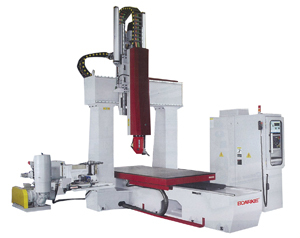
This unit has a laser-light curtain to better protect users. Its vacuum worktable has two zones: one can machine while the other feeds materials simultaneously, with servo motors made in Japan and spindles from Italy.
The machine is specially designed to enable direct cutting on boards without pre-sawing into smaller pieces, eliminating the need to install molds for sawing. This machining center is ideal for complicated work pieces in small volume like cabinet doors, solid-wood doors, computer desks and panel-type furniture, as well as able to machine plastic and soft-metal.
"Its high accuracy eliminates second processing," says Bill Hung, Boarke's chairman. The machine's tolerance of accuracy is only plus and minus 0.00002mm due to a computerized controller based on Windows. "Extreme accuracy is necessary to mass produce knock-down workpieces so the end pieces can easily be assembled by DIYers," he explains.
Security and user friendliness are the major drawing points of this machine: Infrared sensors warn the computer to shut down upon detection of people entering the working area. Also, the control computer can send and receive mails so an operator need not leave the machine running to go to an office to handle emails.
Multi-feature Saw
Kuang Yung Machinery Co., Ltd. debuted the CFS-200A cut-off saw to upgrade its competitiveness. This machine is ideal for cutting pieces for mass production of finger jointers and other parts.
With multi-features as precision cutting, high production efficiency and energy-conservation, this unit is loop-controlled by an optoelectronic sensor, computer and servo motor. "This loop-controlled saw allows the machine to save at least 5% more material than those from other manufacturers," says Joe Chang, the general manager.
In addition, this unit is three to five times more efficient than manually operated cut-off saws. The machine's multi-blade can cut two-meter-long wood products into 10 pieces in only eight seconds, and cut four-meter-long pieces into 10 pieces in only 10 seconds. The CFS-200A's maximum feed rate is 150 meters per minute, with maximum cut frequency of 180 times per minute.
This unit's numerically controlled industrial PC has 32-bit floating-point digital signal processing (DSP) system, which is much more durable than PC-based system for protection against high ambient temperature, unstable voltage and sawdust. Graphic displays on the user screen make the unit user-friendly for all nationalities. "This machine is also affordably priced," Chang stresses.
This other rip saw is also smartly equipped with movable blades controlled by a PC with a sensor that measures optimized cutting width. "This system saves time relative to traditional types that need to be manually adjusted for cutting length," Chang says. The company debuted this machine in May 2009 at a trade show in Germany.
Multi-advantages
Chang says the 49-year-old firm has many advantages over rivals: "We have wide market spread, diversified products, good relationship with sales agents worldwide, and reliable quality."
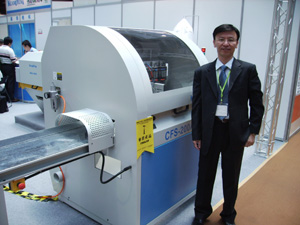
Two partners including a British machinery designer and a Taiwanese electromechanical expert have further sharpened the maker's edge. "Local rivals have little chance to match the design of our electrical control," Chang boasts. And the company's British ally, Chang stresses, is a machinery expert who literally combines textbook-smart with street-smart and cost factor. "His designs are practical despite not having no factories," Chang says, adding that the expert has worked in the field for over 30 years.
The company introduces at least one new machine and five upgraded designs a year. So far, the company has won at least five design patents.
Backed by such advantages, Chang looks forward to recovering quickly to growth after downturn, which he says has been "unprecedented and the worst" in his memory. However, Chang thinks the meltdown did not hit the island's woodworking-equipment industry as hard as the machine-tool counterpart due to the former's higher nimbleness, smaller size and diversified product lines. The bigger scale and less product diversification expose machine-tool manufacturers to higher risks in the form of keeping sizable material inventory, he says.
Downsized Orders
The blessing in disguise of the meltdown has been, Chang analyzes, to drive the island's woodworking-equipment manufacturers to vie for smaller orders for highly customized machines. "Amid more prosperous times, local makers were busy competing for big orders for mainstream machines, setting capacities only for such orders, but no more," he says. He also thinks the recession has taught Taiwan's woodworking-equipment industry a hard lesson in refocusing on customized production. "This is becoming our niche and those who don't see it will be left behind," he comments.
Mainstream orders, he says, are being snatched up by mainland Chinese manufacturers, who survive by copying Taiwan-made machines. But copycatting and shoddy quality, Chang says, are costing mainland's equipment manufacturers in the long-run: Many buyers have returned to Taiwanese suppliers, realizing forsaking quality for cheaper prices is often a formula for disaster.
Eroding Edge
Also, China's manufacturers are gradually losing their edge as rising labor cost and Chinese yuan against the greenback. "Most of all, Taiwanese equipment suppliers' subcontractors are now eager to jointly work to cut costs and develop built-to-order machines," he says.
China may be a huge market for several industries but not for Taiwan's woodworking machines, Chang emphasizes. "Material preparers and woodworking-products manufacturers stateside and Europe are our targets for rip saws and cut-off saws."
Diversifying Products
The recession drove Big Toyo Machinery Co., Ltd., coating-equipment maker, to cross over into non-woodworking machinery sector by building efficient and eco-friendly machines with its core technologies, with the HAC1500, an automatic painting machine, being an example.
Unique design makes this painter material-efficient and eco-friendly, featuring compressed-air spray nozzle, air intake and exhaust, and reclamation system. This painter can handle solvent-based and water-based paints, and is PLC controlled with a touch-screen.
The unit's 100-kg per-square-centimeter pressure enables even coating, with the "exact pressure carefully calculated," says chairman Roger Fan, a 28-year veteran who graduated from the National Taipei Institute of Technology.
"Our tests prove that one more kilogram per-square-centimeter would result in excessive spray and one less kilogram would be inadequate coverage," says Fan. To ensure consistent pressure, Fan adds an auxiliary compressor. Such design in the HAC1500, Fan boasts, saves 19% more paint relative to traditional machines from rivals.
Minimizing Waste
This machine also minimizes waste, Fan claims, with its reclamation system able to save 20% in paint by collecting coatings that fall, which are filtered and then recycled. "Our machine saves nearly 40% in paints overall as compared with traditional machines," Fan boasts.
The machine's air intake has a filter that cleans the air to be compressed to minimize particulates contaminating finished workpieces, with the exhaust system forcing out 0.6 cubic meters of air per-second.
The HAC1500 coats eight meters per-minute, twice that of its predecessor. "The key to the faster speed is precise spraying, which significantly reduces need for repeat spraying," Fan says. Coating length is unlimited while maximum coating width is 1.5 meters.
Fan claims he is the first Taiwanese woodworking-equipment supplier to build a compressed-air painter, differing from traditional ones using fans to coat workpieces. So far, he has won at least seven patents.
The company has shipped 10 painters to mostly wood-panel manufacturers.
In recent years, the company has begun supplying painters for housings of IT products as PCs and mobile phones as well as automotive dashboards. "Making machines for IT products calls for tighter tolerances than for woodworking pieces," Fan stresses. As requested by customers, the company has introduced IT equipment painters that only allow particulates under 10 microns in diameter into spraying chamber.
Asked not to raise prices while bettering efficiency, the company, Fan says, can only boost self-content rates and streamline manufacturing.
Fan thinks the downturn has pushed wood product manufacturers worldwide to use less-expensive automatic machines to reduce labor input, generating more business potential for Taiwanese equipment suppliers. But he also believes equipment suppliers specializing in back-end machines like painters stand better chance to land orders than front-end equipment suppliers specializing in cutters. "Taiwanese woodworking equipment suppliers are world renowned for sculpting machines, which are semi-manual to cope with complicated work. Fortunately back-end equipment mostly handles simple processing that can be designed to be fully automatic," Fan elaborates.
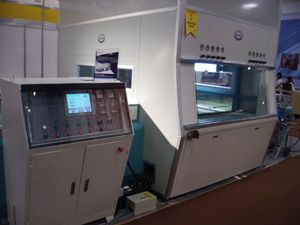
Equaling Germans
Leadermac Machinery Co., Ltd. is promoting two edging machines-the LMC 1023T four-side molder and a tool change system for CNC machines. The molder is numerically controlled and equipped with four to 10 spindles with 1 13/16 inch, 50mm and 2 1/8 inch in diameters, with 6,000, 7,200 and 8,000 RPMs.
This machine's average processing efficiency of 150 meters-per-minute is reportedly nearly quadruple that of generic types. "Such output is now only achieved by Leadermac's molders and German molders," claims Michael Chang, the CEO. Also, this machine's processing tolerance is only plus and minus 0.02mm, in line with rising demand from DIY-furniture fans for precision parts, according to Chang.
Controlled by Windows-based PLC program and delivered with operating manual in seven languages, this machine is mostly shipped to Europe and the U.S., as well as being ideal for making wood furniture, wood flooring, kitchen furniture, and building materials.
The company's efficient tool change system, able to control six machines at once, boasts tool calibration time of only five minutes, compared with reported 30 minutes in other systems. "We work with dedicated software and hardware companies," Chang says.
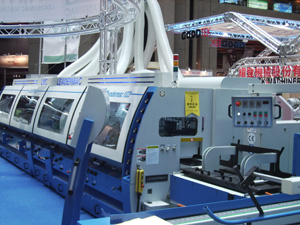
Branching Out
Blue Steel Machinery Co., a leading Taiwanese maker of horizontal band resaws, has recently branched out into resaws for cutting parquets, instead of focusing on cutting lumber, with many efficient designs being added.
The new models are HP-1000P and HP-1300-2. "The saw blades are designed to cut wood at 10-degree slant, much neater and smoother than zero-degree counterpart," stresses chairman Roger Yeh, adding that slant cutting progresses at over 15 centimeters per-second.
Yeh stresses that waste reduction is now a key design criteria for saws. "Wasting wood simply costs in more ways than one, not least of which involves disposal, so no equipment user wants excessive waste from cutting." Therefore the company builds machines capable of cutting to result in nearly-finished surfaces, hence minimizing secondary finishing at added cost to require only planing etc. Such is achieved by using refined-tooth tungsten-steel blades from a well-known American supplier, which results in cuts of only plus and minus 0.2 mm, boasts Yeh. While slim blades allow the company's machines to slice wood to a minimum of 3mm thick.
Both HP-1000P and HP-1300-2 are driven by 30-HP motors, with feeding speeds on the two machines being adjustable and maximum of 12 meters-per-minute.
The two saws are outfitted with several precision components, including a piloted check-valve to accurately position the elevation-wheel, as well as a PLC control unit with a touch screen.
Also, intake and output pressure rollers on buffering cylinders help to significantly boost processing precision; while each saw head is controlled by individual frequency inverter to allow speed changes.
The HP-1000P and HP1300-2 are CE certified, with the latter being U.S. patented, one of among the 40 the company has registered in the U.S., Taiwan and China.
The hydraulic elevation system replaces the screw gearbox as the major means to raise the machine due to faster speed, as well as needing minimal maintenance, says Yeh.
Main Markets
Blue Steel's top-three markets are the U.S., China and Russia. Yeh says his company outdoes German and Italian suppliers in Russia's low- and mid-range markets, adding that his company markets machines in the U.S. through affiliate High Point Tools Corp., which according to Yeh is the No. 2 American brand of horizontal band saws, while Blue Steel is the only such supplier in Taiwan.
Yeh admits that some horizontal band saw suppliers are emerging in China, but with low quality and hence not a threat. "Ours deliver eight times the output of theirs, and ours need only two operators rather than the typical four."
Edger Specialist
Well Lane Machinery Co., Ltd. is promoting its specialty in the form of two value-added models-a factory-type edge-banding machine with a specially-designed transmission belt that conveys boards to be edge-banded and a multifunctional banding machine for do-it-yourselfers.
"Older factory machines' transmission belts tend to tremble to shake workpieces off, compromising accurate banding," notes Jack Chang, the chairman. Overcoming such issue by developing a precision-capture, the maker's latest machine can handle boards as short as 55-millimeters, with maximum speed being 25 meters per minute.
The firm's multifunctional DIY machine can automatically convey boards for banding as well as corner rounding, with the minimum board to be handled being 300 millimeters.
Chang says that growing eco-protection sentiment drives development of the edge-banding machine market. The company supplies machines to press natural wood and artificial wood veneers on recycled wood boards. "With stringent controls on exports of natural woods worldwide, furniture and wood product manufacturers are using mostly boards of recycled wood," Chang explains.
Depending on various labor cost borne by customers, the company supplies fully automated machines controlled by PCs and mechanical controls. Using mostly locally sourced components, the maker however uses European imports crucial to manufacturing precision as motors, ball bearings etc.
Before opening his business in 1992, Chang worked as an engineer for an importer of German-made edge-banding machines, allowing him to build expertise.
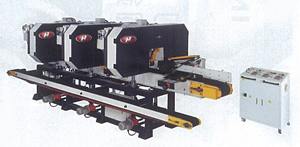
Upgraded Sanders
Goign.E Machine Co., Ltd., a sander specialist, has recently added several advantageous designs to its machines. One such feature is an auto-emergency liftoff: enabling the sander to separate from a workpiece upon glitches as broken belt to avoid over-sanding. "Although each machine has a brake, but without the liftoff the time taken to fully stop the sander will still damage a workpiece," says Roger Lou, the general manager.
Lou has been in the industry for over 25 years and his company's machines are built specifically to produce furniture, one-piece wood panels, parquet boards and veneer-finished boards. "We have the widest range among the five or six domestic manufacturers," Lou boasts.
The "Elegant" series of wide-belt sanders is the company's signature products, designed to handle widths of 24, 36, 42, and 52 inches, and a maximum of five to six inches board thicknesses, as well as being driven by motors rated 7.5-HP to 30-HP.
Besides the ingenious liftoff, the Elegant series of sanders are also equipped with several practical components, including an automatic belt tracking unit, a various-speed feed conveyer, an easy-to-use central control panel, a sensitive belt control, a touch-to-stop emergency bar, a convenient thickness gauge, and a braking system.
Mostly an OEM, the company ships products to Europe, the U.S. and Asia, with products being CE and CSA approved.




